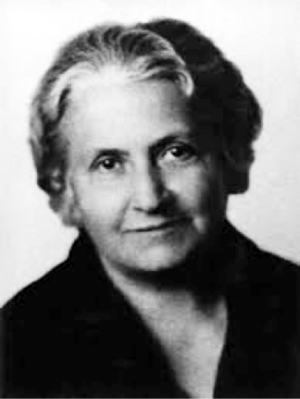“This is education, understood as a help to life; an education from birth, which feeds a peaceful revolution and unites all in a common aim, attracting them as to a single centre. Mothers, fathers, politicians: all must combine in their respect and help for this delicate work of formation, which the little child carries on in the depth of a profound psychological mystery, under the tutelage of an inner guide. This is the bright new hope for mankind.”
ABOUT DR. MARIA MONTESSORI

“Maria Montessori Archival Video.” Association Montessori Internationale, AMI Montessori, 31 Aug. 2020, montessori-ami.org/resource-library/videos/maria-montessori-archival-video.
Dr. Maria Montessori graduated from the Faculty of Medicine of the University of Rome in 1896, and was the first woman to practice medicine in Italy. As a physician, anthropologist and scientist, she brought a new perspective to the observation and study of human development. It is through scientific observation that she came to understand how children interact with the environment, including the people in it. She identified distinct stages of human development through her observation of children from many ethnic, cultural and socio-economic backgrounds from birth to maturity. Her understanding of human development, including the nature of children and how they naturally learn, was the basis for the development of activities and materials to serve child’s desire to learn and discover of the world.
In 1901 Montessori began her own studies of education, philosophy and anthropology. During this time, children were left at home as their parents worked. The number of children needing a guide and role model presented Maria with an opportunity to work with children with normal development and push her ideas into the mainstream.
In 1907, Dr. Montessori opened the first Casa dei Bambini in Rome. Dr. Montessori put many different activities and materials into the children’s environment and observed the children’s use of them. She kept only those materials that engaged them. She came to realise that children placed in an environment with activities designed to support their natural development, had the power to educate themselves.
By 1909 Dr. Montessori gave her first teacher training course in her new approach to around 100 students. Her notes from this period provided the material for her first book published that same year in Italy, appearing in translation in the United States in 1912 as The Montessori Method, and later translated into 20 languages.
A period of great expansion in the Montessori approach now followed. Montessori societies, training programmes and schools sprang to life all over the world, and a period of travel with public speaking and lecturing in America, the UK and throughout Europe occupied Dr. Montessori.
In 1929, she and her son, Mario, founded the Association Montessori Internationale (AMI) to protect the integrity of her life’s work. Today, AMI is the oldest Montessori organization in the world, organizing courses and training for the world’s best Montessori teachers, keeping various authentic Montessori schools, disseminating information about Montessori ideas and activities and assuring all AMI teachers and schools to the highest international quality standards for Montessori education.
Dr. Maria Montessori received her nomination for the Nobel Peace Price in 1949, three years before she passed away in 1952.
Short biography of Dr. Maria Montessori (1870 – 1952), Nobel Loreate (1949)
Source – AMI Canada
